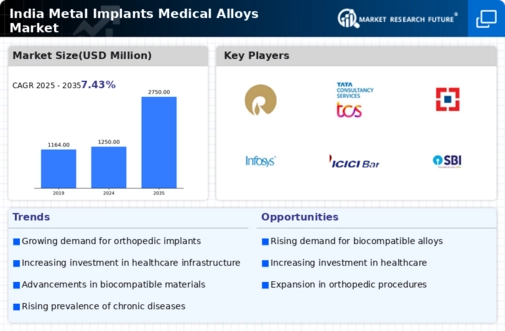Growing Aging Population
The aging population in India is a crucial driver for the growth of the metal implants-medical-alloys market. As individuals age, the incidence of orthopedic and cardiovascular diseases tends to rise, leading to an increased demand for metal implants. According to recent estimates, the population aged 60 and above is projected to reach 300 million by 2050, which could significantly boost the need for surgical interventions involving metal implants. This demographic shift necessitates the development and supply of advanced medical alloys. These alloys must meet the specific requirements of older patients, such as enhanced biocompatibility and mechanical strength. Consequently, the metal implants-medical-alloys market is likely to experience substantial growth as healthcare providers adapt to the needs of this expanding demographic.
Rising Healthcare Expenditure
India's healthcare expenditure has been on an upward trajectory, which positively influences the metal implants-medical-alloys market. The government has been increasing its budget allocation for healthcare, aiming to improve infrastructure and access to medical services. In 2025, healthcare spending is expected to reach approximately 3.5% of GDP, which translates to a significant increase in funding for medical technologies, including metal implants. This rise in expenditure allows for the adoption of advanced medical alloys that enhance patient outcomes and reduce complications. As hospitals and clinics invest in better technologies, the demand for high-quality metal implants is likely to surge, thereby propelling the growth of the metal implants-medical-alloys market.
Government Initiatives and Policies
Government initiatives and policies aimed at enhancing healthcare access and quality are pivotal for the metal implants-medical-alloys market. The Indian government has launched various schemes to promote medical device manufacturing and reduce import dependency. Initiatives such as the Production-Linked Incentive (PLI) scheme encourage domestic production of medical devices, including metal implants. This policy framework is expected to stimulate innovation and investment in the metal implants-medical-alloys market, fostering a competitive environment that benefits both manufacturers and patients. As these initiatives take effect, the market is likely to witness increased production capabilities and improved access to advanced medical alloys.
Technological Innovations in Healthcare
Technological innovations in healthcare are transforming the landscape of the metal implants-medical-alloys market. Advances in manufacturing techniques, such as 3D printing and computer-aided design, enable the production of customized implants tailored to individual patient anatomies. These innovations not only improve the fit and functionality of implants but also reduce surgery times and recovery periods. In India, the adoption of such technologies is gaining momentum, with several hospitals investing in state-of-the-art equipment. This trend suggests that the metal implants-medical-alloys market will continue to expand as healthcare providers seek to enhance surgical outcomes through innovative solutions.
Increasing Incidence of Chronic Diseases
The rising incidence of chronic diseases in India is a significant driver for the metal implants-medical-alloys market. Conditions such as diabetes, obesity, and cardiovascular diseases are becoming more prevalent, leading to a higher demand for surgical interventions that often require metal implants. For instance, the prevalence of diabetes in India is projected to reach 134 million by 2045, which correlates with an increased need for orthopedic and cardiovascular surgeries. This trend indicates that the metal implants-medical-alloys market will likely see sustained growth as healthcare systems respond to the challenges posed by chronic diseases, necessitating the use of advanced medical alloys.

















Leave a Comment